Studies on the effluent generated during the pulping process in paper industry
Preeti Nandkumar1 *
1
M.P. Christian College of Engineering and Technology,
Bhilai,
India
DOI: http://dx.doi.org/10.12944/CWE.3.1.30
Environmental pollution has become a cause for great concern as it continues to increases rapidly day by day. One of the major toxic pollutants comes through paper industry. It directly or indirectly in one form or other pollutes the environment. Pulping additives such as quinone-based additives have been used in the experimental work for the alkaline pulping of. Ipomoea Carnea Jacq (Beshram ). In the present paper a thorough study has been done on the chemical analysis of the effluent from different storms, pollution load of the soda extraction stage effluent and pulp washer effluent was analyzed and studied. This pollution load affects the environment creating a wreak havoc on the surrounding eco system.
Copy the following to cite this article:
Nandkumar P. Studies on the effluent generated during the pulping process in paper industry. Curr World Environ 2008;3(1):189-193 DOI:http://dx.doi.org/10.12944/CWE.3.1.30
Copy the following to cite this URL:
Nandkumar P. Studies on the effluent generated during the pulping process in paper industry. Curr World Environ 2008;3(1):189-193. Available from: http://www.cwejournal.org/?p=805
Download article (pdf)
Citation Manager
Publish History
Select type of program for download
| Endnote EndNote format (Mac & Win) | |
| Reference Manager Ris format (Win only) | |
| Procite Ris format (Win only) | |
| Medlars Format | |
| RefWorks Format RefWorks format (Mac & Win) | |
| BibTex Format BibTex format (Mac & Win) |
Article Publishing History
| Received: | 2008-03-12 |
|---|---|
| Accepted: | 2008-05-17 |
Introduction
Ever increasing growth of industrialization causes gigantic problem of environmental pollution.The large volume of water consumed by Indian industries for various processes and the discharging of effluents done on to adjoining areas creates pollution. Industrial effluent is a complex liquid flowing out of the mill in enormous quantities. The quantities required represent the requirement of nearly 4000 per ton per day. These liquid effluents contain higher concentration of organic and inorganic pollutants. Rapid growth of industrialization has affected not only surface water but also ground water.
All industrial waste water affects in some way the normal life of streams, such as river and ponds etc. when the stream is over saturated with a specific pollutant, it becomes an effluent and has to be treated. Majority of effluents from sugar, distillery, pulp and paper industry contain organic wastes which is to be removed reducing COD and BOD values of the effluents does this. The left over that result from pulp and paper manufacturing include chemical compounds formed during papermaking, due to enormous quantity of waste water they generate thus the pulp and paper industry is considered a major industry with regard to waste water.
The greatest pollution threat in the wastewater of pulp and paper factories are the by-products from bleaching process that form when chlorine atoms bind to organic molecules in the pulp. These are the organochlorine in the pulp. These organochlorine byproducts are known as dioxins and furans, which are extremely toxic. BOD is a parameter for the concentration level of dissolved organic pollutant in the wastewater. Pulp mills are voracious water user.
Material and Methods
Ipomoea carnea Jacq sample was collected from Vidisha district, Raisen district of M.P. and Lalitpur district of U.P. respectively. The wood samples was cleaned and chipped. The chips were chipped in the chipper .The chips were air dried and allowed to have uniform 12% moisture content. The screened chips were used in the experimental work. Cooking procedure and all the pulping experiment were carried out in an autoclave bomb digester, which consists of six stainless steel bombs. Each rotating in polyglycol bath .The cooking of chips was done keeping a control of soda digester for each set of experiment. Various additives such as anthraquinone, anthrone, 2.6.dichloroquinone4 chlorimde, and 8 hydroxyquinoline were added to get optimum dose. Black liquor extracted from each sample of pulp and additive mixture is collected and examined to check the various pollution parameter of water.
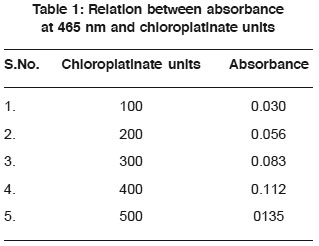 |
Table 1: Relation between absorbance at 465 nm and chloroplatinate units Click here to view table |
Results and Discussion
Table 1 shows the relation between absorbance at 465 nm and the chloroplatinate units.the criteria for selecting the 465 nm wavelength is the position of the absorbent maximum Pt-Co complex at this wavelength. The wavelength falls just at the boundary of violet and blue region of the spectrum .A curve can be plotted against color unit. The curve will show a steady increase in absorbance with respect to chloroplatinate units. Color is directly proportional to the absorbance.
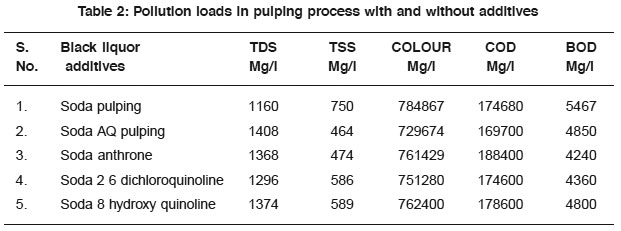 |
Table 2: Pollution loads in pulping process with and without additives Click here to view table |
Table 2 shows the pollution load in pulping process with without additives of black liquor .it is clear from the table that all the parameter of pollution was lower in case of soda AQ pulping except a little high value of TDS than others, wheras the load of black liquor and soda pulping was having higher pollution load.
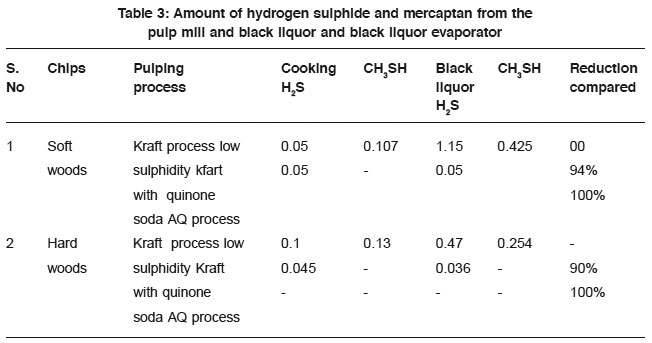 |
Table 3: Amount of hydrogen sulphide and mercaptan from the pulp mill and black liquor and black liquor evaporator Click here to view table |
Soda AQ pulping which is an alternative to Kraft process it will extent lower pollution load, particularly of water and air. Results in table III shows that the mercaptan formation and loss in sulphur in the form of organic sulphur that has been eliminated in soda AQ process. Thus pollution load due to sulphur at different stage was completely eliminated by employing soda AQ process.
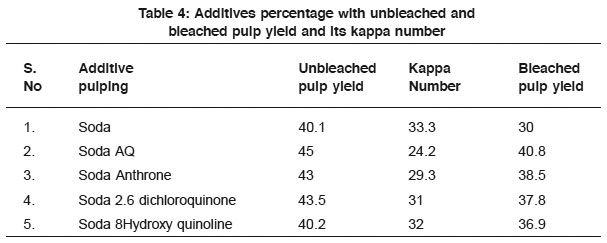 |
Table 4: Additives percentage with unbleached and bleached pulp yield and its kappa number Click here to view table |
Table 4 shows the yield and kappa number of unbleached pulp and other quinone additives carbohydrate dissolution was almost the same as in case of soda pulping .the fraction of COD are on the higher sides. Spent liquor for soda 2.6 dichloroquinone 4 chlorimide pulping shows higher BOD and COD value. Soda AQ pulping proceeds spent liquor with BOD and COD. Colour varies marginally and slightly higher solid content that was due to the dissolution of more lignin during pulping.It was observed that additives did not have any influence on the suspended solids in the pulping liquor.
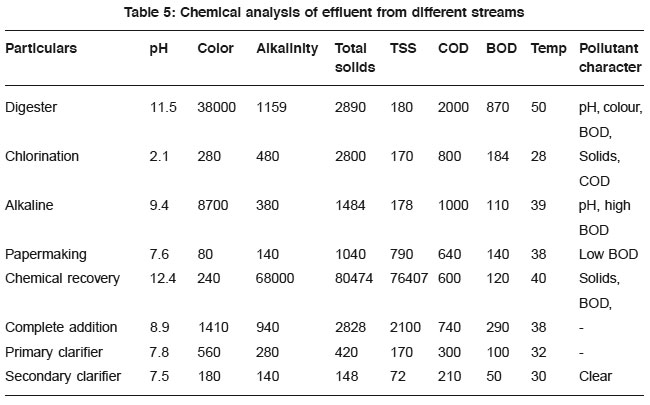 |
Table 5: Chemical analysis of effluent from different streams Click here to view table |
Without using additives at ideal conditions results obtained from various streams of effluent mixed during the treatment of effluent plant i.e. primary and secondary clarifier is expressed in Table 5.
 |
Table 6: Pollution load of soda extraction stage effluent during bleaching of pulp Click here to view table |
Table 6 shows alkali extraction stage effluent from soda AQ pulping which has lower COD and BOD.Soda pulping and pulping with other additives shows bleached pulp yield due to the degradation during bleaching which results in high BOD and COD load. Soda AQ helps in the reduction of pollution load by producing less degraded pulp with low kappa number.
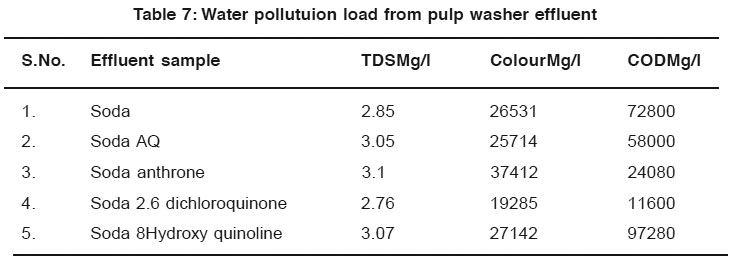 |
Table 7: Water pollutuion load from pulp washer effluent Click here to view table |
Results in table 7 show the various pollution loads in washing of pulp produced with different additives .the colour of the washing of soda AQ and soda pulp are significantly lower than the other pulp washing. Washing from soda AQ, soda anthrone, and soda 2.6 dichloroquinoline 4 chlorimide as lower values as compared to soda pulping and soda 8hydroxy quinoline.
Conclusion
The soda pulp was with quinone additives, which completely eliminated mercaptan formation and loss of sulphur. It can be conclude that odour nuisance is complete eliminated the addition of quinone additives in soda pulping and the effluent load can be lowest by the quinone additives. The BOD reduction is due to the higher retention of carbohydrate fraction in the pulp and reduction in the alkali extraction stage effluent due to low kappa number.
In soda anthraquinone spent liquor there was a significant reduction in BOD value than in COD as compared to soda pulping spent liquor .The BOD reduction was 29% whereas COD reduction was only marginal about 3%. There was not significant reduction in COD and BOD in Soda.2.6 dichloroquinone 4 chlorimide pulping liquor. Spent liquor from 8 hydroxy quinoline showed highest pollution load.
References
-
U.S.National Pollutant release inventory. (1996).
-
British Columbia COFI Pollution Prevention Workshop. (1997).
-
Environment Canada PPER Consultation (2000).
-
EPA ,Profile of the pulp and paper Industry,EPA/310/R-95?015, September, (Environmental protection Agency.) (1995).
-
Standard Methods for the examination of water and waste water (19th edn) American public health association, Newyork (1995).
-
Official methods of analysis, association of official analytical chemists, AOAC (1975).
-
Train.R.E. Quality criteria for water , EPA,Washington 256 (1979).
-
ISI, Standard Specification for drinking water, New Delhi, (1983) 15: 1050.
-
Metcalf and Eddy Inc. Waste water engineering treatment, disposal &Reuse, Tata McGraw Hills, New Delhi (1979).
-
Eckenfelder Jr.W.W.,Principals of Water quality Management.CBI,Newyork. 1980)
-
Azad, H.S.Industiral waste water management hand book, McGraw hill. New York.(1976).
-
Bessliers, E.B, M.Scwartz, Treatment of industrial wastes 2 edn (1975).
-
Hammer M.J., Water and waste water technology, Wiley eastern publication. New York (1975).
-
Parker .H.J., Waste water system engineering, Prentice Hall. Eagle wood cliffs (1975)
-
Patterson. J.W. Waste water treatment Technology Ann Arbon Science ,Michigan (1975).
-
Schroeder E.D., Water and waste water technology, McGraw hill, New York (1977).
-
Culp.R.L.Werner M.G.,Handbook of advance waste water treatment, 2 edn Angstrom Reinhold,Newyork (1978)
-
Advances in waste water treatment AIChe today series. Waste water treatment Today series, (1976) 15A: 56.
-
Easton, Genetic toxicity of pulp mill effluent juvenile, salmon (1997).
-
Gullichsen, j, the changing of Kraft pulping process, proceedings international chemical conferences Toronto Ontario. April 1990-95.






